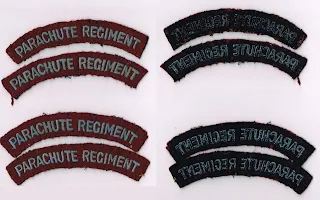Recently a reader of the blog who is also in a WWII Parachute Regiment reenactor group, posed a question regarding the “correct” shoulder insignia found in the right sequence on the battledress of the period. Less and less frequently is the genuine article offered for sale, let alone on eBay. The next question immediately arises, as to whether showing the real thing with a semi-forensic analysis for the benefit of the collector, outweighs the detriment of providing the counterfeiter with the added insight to better their next edition of a given badge.
Just a brief review.The Parachute Regiment and the Glider Pilot Regiment were officially formed by SPECIAL ARMY ORDER A.O. 128/1942 dated 31 August 1942. It’s this collector’s personal opinion that the majority of airborne collectors acknowledge that the first Parachute Regiment unit designation strip (worn just below both shoulder seams of the battledress blouse) was dark blue “PARACHUTE REGIMENT” (sans-serif) lettering on a light blue background. This was authorized on or shortly after ACI (Army Council Instruction) 905 dated 12 June 1943 which officially established regimental designations for the Parachute Regiment and the Glider Pilot Regiment. The strips came in both a printed and embroidered version.To the best of this author’s knowledge, this remained the only officially authorized regimental designation strip for the remainder of WWII, although there was a wide variety of unauthorized variants also worn as shown in numerous historical photographs.
The following first embroidered pair, at least from the front (without seeing the backs), appear to be righteous. The second printed title, and the third embroidered example, also appear to be genuine.
Although continuing to research, at some date after the end of WWII, currently not established by this author, an official transition occurred to a unit designation strip worn in the same location which was light blue “PARACHUTE REGIMENT” (serifs) on a maroon background. Its authorized wear was terminated when battledress was phased out, which in limited cases was as late as the early 1960's. The following is a pair of images showing both sides of what I believe to be a genuine pair. Please observe the following attributes/features:
• The colours, both shade and chroma, used
• The use of consistent serifs can be observed both front and back
• The regularity and consistency of the overall centering and spacing of the lettering
• The regularity of the overall dimensions of the strip
• The consistent diagonal and regularity of the stitching of the lettering
• On the reverse the absence of irregularity and cross-over stitching, common in reproductions
• The characteristics of the backing material, trimming of same, and the sticth marks (would appear one was issued, one was not) This in an otherwise identical pair, being offered as such, is somewhat troublesome, i.e. not a matched pair).
Compared with the vast majority of copies currently on the market, these features are even more readily discernible.
This second 2 pair of unit designation strips also appear righteous in this author's personal opinion.
Apparently this configuration was available in both embroidered and printed configuration. The following printed pair (sans serifs), though extremely very well done, have been specifically identified by the seller as reproductions. Two clues are no serifs and the lack of bleed-through present in the majority of the backs of WWII printed insignia, Under these set of circumstances the collector's only safeguard is limited to provenance.
Here is another example of reproduction designation strips. Notice the thinness of the letters and spacing, and the maroon color and texture of cloth.











2 comments:
Hello Again Jim,
This is lovely detail and I thank you for establishing a very nice form to read from.
I pose another question to you on the subject of cloth insignia; what officer rank backing colours are associated with infantry type? By reference of historical photographs that were originally shot in colour, I have noticed key differences in the cloth pips of officers in the British army during WWII. I.e., officers in standard infantry regiments wore cloth stars/crowns on their epaulettes with a scarlet red outline whilst officers of the parachute regiment had a maroon outline. Intelligence Corps as another example had an emerald green outline.
Here's a few times I've noticed it:
https://anglotopia.net/wp-content/uploads/2015/02/britarmyranks.gif
https://www.thesun.co.uk/wp-content/uploads/2017/06/nintchdbpict000329903395.jpg
https://images.fineartamerica.com/images/artworkimages/mediumlarge/3/general-sir-bernard-montgomery-1943-war-is-hell-store.jpg
There is a single
Hello Thire,
Obviously you have opened a rather complex subject area. My principal reference source for WWII is, Davis, B.L., British Army Uniforms & Insignia of World War Two, Arms & Armour Press, London, 1983, ISBN 0-85368-609-2; Part II: pp.16 – 118. For more current information I can suggest; https://rmhistorical.com/files/content/UKSC%204552%20Iss%2016%20Technical%20Specification%20for%20Insignia%2C%20Rank%20Slide%2C%20MTP.pdf
https://assets.publishing.service.gov.uk/government/uploads/system/uploads/attachment_data/file/626107/2017-03109.pdf
https://www.whatdotheyknow.com/request/393927/response/959318/attach/8/ADR%20Part%209.pdf?cookie_passthrough=1
Hopefully, if you don’t already have the information, this will provide you with further assistance.
Post a Comment